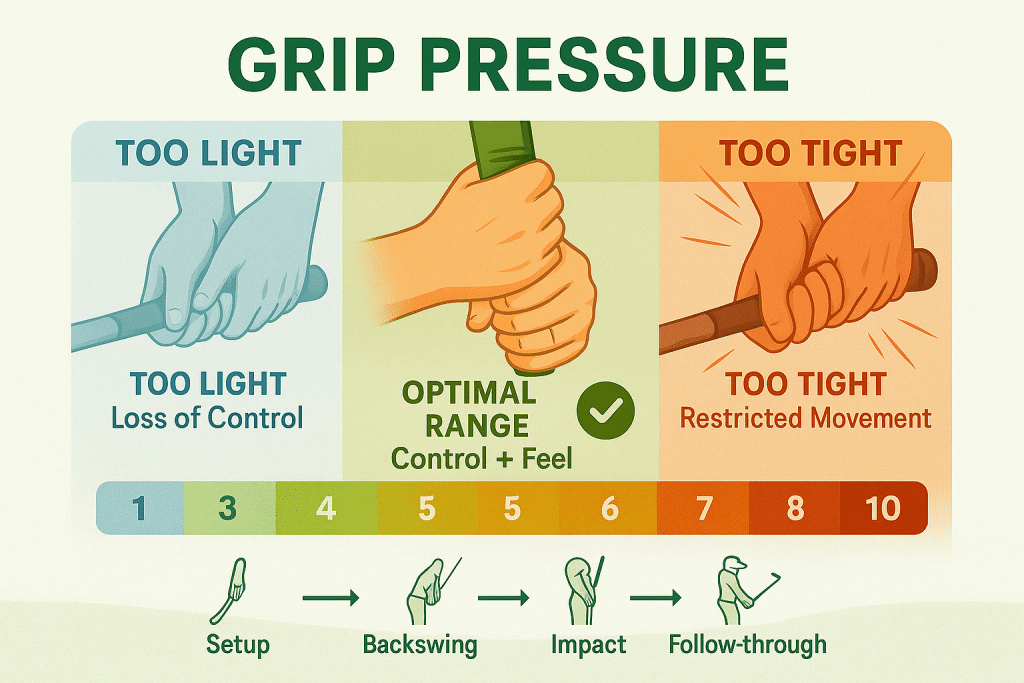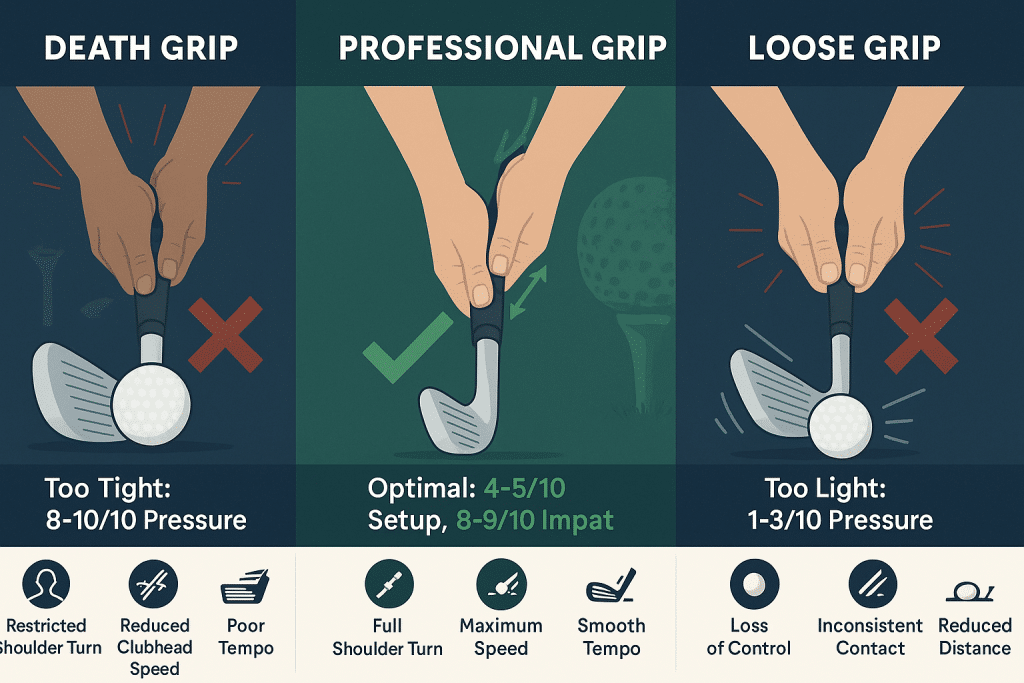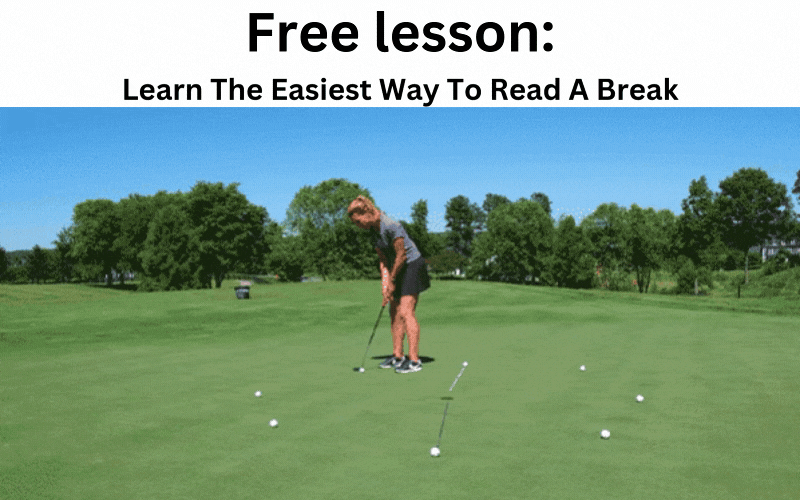Master the art of grip pressure to unlock consistent ball striking, increased power, and professional-level control in your golf game.
Key Takeaway: Professional golfers maintain 4-5 grip pressure on a 1-10 scale at address, gradually increasing to 8-9 at impact while keeping tension focused in the fingers rather than the palms or forearms.
Golf grip pressure might seem like a minor detail, but it's actually one of the most critical fundamentals that separates amateur golfers from professionals.
Research shows that 85% of amateur golfers either grip too tightly (causing tension) or too loosely (losing control), directly impacting their swing mechanics, ball striking, and overall performance.
Understanding proper grip pressure isn't just about holding the club—it's about creating the ideal connection between your body and the club that allows for maximum power transfer, precise control, and consistent shot-making.
Whether you're struggling with slices, hooks, or inconsistent contact, mastering grip pressure can be the game-changer you've been searching for.
Table of Contents
- Understanding Grip Pressure Fundamentals
- The Science Behind Optimal Grip Pressure
- Professional vs. Amateur Grip Pressure Patterns
- How to Find Your Perfect Grip Pressure
- Grip Pressure for Different Shots
- Common Grip Pressure Mistakes
- Advanced Grip Pressure Techniques
- Practice Drills and Training
- Equipment Considerations
- Troubleshooting Your Grip Pressure
Understanding Grip Pressure Fundamentals
What exactly is grip pressure? Grip pressure refers to how firmly you hold the golf club throughout your swing.
Unlike the common misconception that associates "strong" or "weak" grips with pressure, this article focuses specifically on the force applied by your hands to the club handle.
Professional golf instructors measure grip pressure on a scale of 1-10, where:
- 1 = So light the club barely stays in your hands
- 5 = Firm enough for control without tension
- 10 = Gripping as tightly as possible
The key insight from touring professionals: Grip pressure isn't static throughout the swing. It starts moderate at address and increases significantly through impact, then relaxes during the follow-through.

The Foundation of Proper Grip Pressure
Before diving into pressure specifics, you must establish a correct grip foundation. As covered in our comprehensive guide on golf swing fundamentals, proper hand placement creates the framework for effective pressure application.
Your grip pressure should originate from:
- Primary control: Index finger and thumb of lead hand
- Secondary support: Ring and pinky fingers of trail hand
- Stabilization: Middle and ring fingers of lead hand
Visual indicator: Hold a club at address and check that your forearms feel relaxed while maintaining complete club control. If your forearms feel tense or rigid, you're likely gripping too tightly.
The Science Behind Optimal Grip Pressure
Recent biomechanical research reveals fascinating insights about grip pressure's impact on swing performance.
Studies using pressure sensors show that professional golfers maintain surprisingly consistent pressure patterns, while amateurs exhibit erratic variations that directly correlate with poor ball striking.
The Tension Transfer Effect
When you grip the club too tightly, tension immediately transfers up your arms to your shoulders, creating a cascade of swing problems:
- Restricted shoulder turn (reducing power by 15-20%)
- Limited wrist hinge (decreasing clubhead speed)
- Premature muscle fatigue (affecting consistency over 18 holes)
- Reduced feel and touch (particularly around the greens)
PGA Tour instructor Jason Baile explains this principle perfectly: "If I pull up into the grip, I can still have supple wrists, elbows, and soft shoulders, yet have really good control of the face."
The Physics of Power Transfer
Conversely, gripping too lightly creates different but equally problematic issues:
- Club face rotation during the swing
- Loss of lag in the downswing
- Inconsistent impact position
- Reduced distance due to poor energy transfer
The sweet spot: Professional-level grip pressure allows maximum clubhead speed while maintaining precise control through impact.
Professional vs. Amateur Grip Pressure Patterns
Professional golfers and high-level amateurs demonstrate remarkably different grip pressure patterns throughout their swings. Understanding these differences provides a roadmap for improvement.
Professional Pressure Pattern
Setup (4-5/10): Professionals start with moderate pressure, ensuring club control without creating tension.
Backswing (3-4/10): Pressure actually decreases slightly during the backswing, allowing for full shoulder turn and proper wrist hinge.
Transition (5-6/10): Pressure begins increasing as the downswing initiates.
Impact (8-9/10): Maximum pressure occurs at impact, ensuring solid contact and club face control.
Follow-through (3-4/10): Pressure immediately releases, allowing for full extension and proper finish.
Amateur Pressure Pattern
Most amateur golfers exhibit one of two problematic patterns:
Pattern 1 - The "Death Grip":
- Setup: 7-8/10 (too tight from the start)
- Throughout swing: Maintains excessive pressure
- Result: Restricted movement, loss of power, poor tempo
Pattern 2 - The "Loose Grip":
- Setup: 2-3/10 (insufficient control)
- Impact: 4-5/10 (still too light)
- Result: Club face rotation, inconsistent contact, reduced distance
How to Find Your Perfect Grip Pressure
Finding your optimal grip pressure requires systematic experimentation and body awareness. Here's a step-by-step process used by professional instructors:
The Horizontal Club Test
This drill, popularized by top instructors, helps establish baseline pressure:
- Hold the club horizontally in front of your chest with arms extended
- Reduce pressure gradually until the club begins to drop
- Increase pressure slowly until the club returns to horizontal position
- Stop increasing pressure - this is your baseline (approximately 4/10)
Important: This baseline pressure should feel comfortable for extended periods without forearm fatigue.
The Natural Pressure Discovery
For a more individualized approach:
- Stand in normal posture without a club
- Let arms hang naturally at your sides
- Grip the club in this relaxed position
- This natural pressure is your optimal starting point
This method, recommended by leading swing coaches, accounts for individual differences in hand strength and natural tension levels.
The Dynamic Impact Test
To find your impact pressure:
- Start with baseline pressure (4/10)
- Take slow motion swings to impact position
- Gradually increase pressure as you approach impact
- Find the point where you feel maximum control without restriction
- This should be approximately 8-9/10 for full shots
Grip Pressure for Different Shots
Professional golfers adjust their grip pressure based on shot requirements, club selection, and course conditions. Understanding these variations elevates your game from amateur to professional level.
Driver and Long Irons (Full Shots)
Optimal pressure: 4/10 at setup, 8-9/10 at impact
Rationale: Maximum distance requires powerful energy transfer through impact while maintaining swing freedom. As discussed in our SF1 Driver optimization guide, proper grip pressure directly correlates with clubhead speed and distance.
Key points:
- Start with relaxed pressure to enable full shoulder turn
- Increase pressure through downswing for solid contact
- Focus pressure in fingers, not palms
Mid Irons (Accuracy Shots)
Optimal pressure: 4-5/10 at setup, 7-8/10 at impact
Rationale: Mid iron shots prioritize accuracy over maximum distance, requiring slightly increased baseline pressure for better control.
Short Irons and Wedges
Optimal pressure: 3-4/10 at setup, 6-7/10 at impact
Rationale: Short game shots demand maximum feel and touch. Lower pressure enhances sensory feedback crucial for distance control and spin application.
Putting
Optimal pressure: 2-3/10 throughout stroke
Rationale: Putting requires the lightest pressure to maximize feel and prevent unwanted hand action. Consistent light pressure promotes smooth, pendulum-like motion.
Professional tip: Many Tour players use slightly weaker grip pressure when putting compared to full swings, enhancing touch and distance control.
Trouble Shots (Rough, Sand, Wind)
Optimal pressure: 5-6/10 at setup, 9-10/10 at impact
Rationale: Difficult lies and conditions require increased pressure to prevent club twisting and maintain control through impact.
Common Grip Pressure Mistakes
Understanding and avoiding these common errors accelerates improvement and prevents the development of bad habits.

Mistake #1: The "Death Grip"
Problem: Starting with excessive pressure (7-10/10)
Symptoms:
- Rapid fatigue in forearms and hands
- Reduced clubhead speed despite feeling powerful
- Poor tempo and rhythm
- Difficulty with touch shots around the green
Solution: Practice the horizontal club test daily until proper baseline pressure becomes natural. Focus on relaxing forearms while maintaining finger control.
Mistake #2: The "Loose Hold"
Problem: Insufficient pressure throughout swing (1-3/10)
Symptoms:
- Club twisting in hands during swing
- Inconsistent ball striking
- Loss of distance despite good swing mechanics
- Difficulty controlling trajectory
Solution: Gradually increase baseline pressure while monitoring forearm tension. Practice impact drills to develop feel for proper impact pressure.
Mistake #3: Pressure Inconsistency
Problem: Erratic pressure changes during the swing
Symptoms:
- Shot-to-shot inconsistency
- Difficulty with timing
- Unpredictable ball flight patterns
Solution: Develop pressure awareness through slow-motion practice swings, focusing on smooth pressure transitions.
Mistake #4: Wrong Pressure Location
Problem: Applying pressure in palms instead of fingers
Symptoms:
- Reduced feel and control
- Tendency toward hooks or slices
- Difficulty with touch shots
- Hand and wrist discomfort
Solution: Focus pressure application in fingers, particularly the index finger and thumb of the lead hand. Practice club control exercises using only finger pressure.
Advanced Grip Pressure Techniques
Once you've mastered basic grip pressure concepts, these advanced techniques can further enhance your performance.
The Pressure Wave Technique
Professional golfers don't simply increase pressure linearly through the swing. Instead, they create a "pressure wave" that optimizes performance:
- Setup: Moderate pressure (4/10)
- Takeaway: Slight decrease (3/10) for freedom
- Top of backswing: Maintain light pressure (3-4/10)
- Transition: Begin gradual increase (5/10)
- Downswing: Steady increase (6-7/10)
- Impact: Maximum pressure (8-9/10)
- Follow-through: Immediate release (3-4/10)
Differential Pressure Control
Advanced players often use different pressure between hands:
Lead hand: Slightly firmer pressure for control Trail hand: Slightly lighter pressure for speed and release
This differential creates optimal clubface control while maintaining swing speed.
Situational Pressure Adjustments
Windy conditions: Increase baseline pressure by 1 point Cold weather: Decrease slightly to maintain feel Late in round: Monitor for fatigue-induced over-gripping Pressure situations: Consciously maintain normal pressure despite tension
Practice Drills and Training
Developing consistent grip pressure requires specific practice and muscle memory development. These drills, used by professional golfers, accelerate improvement.
Drill #1: The Pressure Scale Practice
Objective: Develop pressure awareness and control
Setup:
- Hold club at address position
- Consciously adjust pressure from 1-10
- Hold each level for 10 seconds
- Notice physical sensations at each level
Practice routine:
- 5 minutes daily
- Focus on levels 3, 5, 7, and 9
- Identify your natural comfortable pressure
Drill #2: Swing with Pressure Focus
Objective: Integrate proper pressure into swing motion
Setup:
- Start with baseline pressure (4/10)
- Make slow motion swings
- Focus on pressure increases through impact
- Return to baseline in follow-through
Progression:
- Week 1: 25% speed swings
- Week 2: 50% speed swings
- Week 3: 75% speed swings
- Week 4: Full speed swings
Drill #3: The Club Drop Test
Objective: Find minimum control pressure
Setup:
- Hold club horizontally at chest height
- Reduce pressure until club begins dropping
- Add just enough pressure to maintain position
- Practice swinging with this baseline
Benefits:
- Establishes personal minimum pressure
- Develops pressure sensitivity
- Prevents over-gripping tendencies
Drill #4: Impact Pressure Training
Objective: Develop proper impact pressure timing
Setup:
- Use impact bag or heavy pillow
- Start with light pressure (4/10)
- Increase pressure through simulated impact
- Focus on finger-based pressure increase
Key points:
- Practice pressure timing without ball contact
- Develop muscle memory for pressure patterns
- Build confidence in pressure control
Equipment Considerations
Your equipment directly affects optimal grip pressure requirements. Understanding these relationships helps you make informed decisions about gear and setup.
Grip Size and Pressure
Standard grips: Require moderate pressure for most golfers
Oversized grips: Allow lighter pressure due to increased surface area, beneficial for golfers with:
- Hand or wrist issues
- Tendency to over-grip
- Large hands
Undersized grips: Require slightly increased pressure, suitable for golfers with:
- Small hands
- Desire for maximum feel
- Strong grip strength
Grip Material Impact
Rubber grips: Provide good traction with moderate pressure
Corded grips: Offer superior grip in wet conditions, allow lighter pressure
Soft compound grips: Require lighter pressure, enhance feel
Firm compound grips: May require slightly increased pressure for control
Glove Considerations
Benefits of gloves:
- Reduce required pressure by 10-15%
- Provide consistent grip in various weather
- Prevent blisters from proper pressure
Professional insight: Most Tour players wear gloves specifically to maintain consistent, lighter grip pressure.
Club Weight and Balance
Lighter clubs: May require slightly increased pressure for control
Heavier clubs: Often allow lighter pressure due to momentum
Proper club fitting: Ensures optimal weight distribution for your grip pressure preferences
Troubleshooting Your Grip Pressure
When grip pressure isn't optimal, specific symptoms appear in your ball flight and swing feel. Use this diagnostic guide to identify and correct pressure-related issues.
Symptom: Slicing
Potential grip pressure causes:
- Too light at impact (allows clubface to open)
- Inconsistent pressure (creates timing issues)
Solutions:
- Increase baseline pressure to 5/10
- Focus on maintaining pressure through impact
- Practice impact position drills
Symptom: Hooking
Potential grip pressure causes:
- Too tight throughout swing (restricts release)
- Wrong pressure location (palm vs. fingers)
Solutions:
- Reduce baseline pressure to 3-4/10
- Focus pressure in fingers, not palms
- Practice release drills with lighter pressure
Symptom: Inconsistent Distance
Potential grip pressure causes:
- Erratic pressure changes during swing
- Starting pressure too high or low
Solutions:
- Develop pressure awareness through drills
- Establish consistent baseline pressure
- Practice pressure wave technique
Symptom: Poor Feel/Touch
Potential grip pressure causes:
- Excessive pressure in short game
- Palm-based rather than finger-based pressure
Solutions:
- Reduce short game pressure to 2-3/10
- Focus on finger control
- Practice putting with minimal pressure
Symptom: Early Fatigue
Potential grip pressure causes:
- Starting pressure too high
- Maintaining excessive pressure throughout swing
Solutions:
- Lower baseline to 3-4/10
- Practice pressure release in follow-through
- Build grip strength gradually
Advanced Applications and Mental Game
Grip pressure extends beyond physical technique into mental game and course management. Professional golfers understand these psychological aspects.
Pressure Under Pressure
Tournament situation: Nervous tension naturally increases grip pressure
Professional strategy:
- Conscious pressure checks during pre-shot routine
- Practice pressure control under simulated pressure
- Use grip pressure as swing key during competition
Course Management Integration
Strategic pressure adjustments:
- Tight fairways: Slightly increased pressure for control
- Long carries: Optimized pressure for maximum distance
- Delicate chip shots: Minimal pressure for touch
Weather Adaptations
Rain/humidity: Maintain normal pressure with quality gloves
Cold conditions: Slightly reduced pressure to maintain feel
Wind: Increased baseline pressure for control
Hot conditions: Monitor for grip slippage, adjust accordingly
Practice Integration with Your Golf Routine
To maximize the benefit of proper grip pressure, integrate these concepts into your existing practice routine and on-course play.
Range Practice Protocol
Warm-up (10 minutes):
- Pressure awareness drills (3 minutes)
- Slow motion swings with pressure focus (4 minutes)
- Gradual speed increase maintaining pressure control (3 minutes)
Technical practice (20-30 minutes):
- Focus on one pressure element per session
- Use golf swing drills incorporating pressure awareness
- Practice different shots with appropriate pressure adjustments
Finishing routine (5 minutes):
- Review pressure sensations from session
- Practice competition pressure routine
- Confirm muscle memory development
On-Course Application
Pre-shot routine integration:
- Address position with baseline pressure
- Waggle to confirm comfortable pressure
- Final pressure check before takeaway
During round monitoring:
- Check pressure after poor shots
- Adjust for changing conditions
- Maintain awareness without over-thinking
Long-term Development Plan
Month 1: Establish baseline pressure and awareness
Month 2: Develop pressure wave technique
Month 3: Integrate situational adjustments
Month 4: Master pressure under tournament conditions
Conclusion: Your Path to Professional-Level Grip Pressure
Mastering golf grip pressure represents one of the most accessible yet impactful improvements available to golfers of all skill levels.
Unlike swing plane changes or major technical modifications, grip pressure adjustments can produce immediate results while forming the foundation for long-term improvement.
Key takeaways for immediate implementation:
- Start with 4/10 pressure at address, increase to 8-9/10 at impact
- Focus pressure in fingers, not palms or forearms
- Practice pressure awareness through daily drills
- Adjust pressure for different shots and conditions
- Monitor pressure under competitive stress
The professional advantage: Tour players don't grip the club differently because they're more talented—they grip it correctly because they understand these principles.
By implementing proper grip pressure, you're adopting the same fundamental approach used by the world's best golfers.
Your next steps:
- Practice the horizontal club test for baseline pressure
- Implement pressure wave technique in range sessions
- Monitor grip pressure during your next round
- Consider equipment adjustments to optimize pressure requirements
Remember, as highlighted in our golf fundamentals guide, grip pressure is just one component of excellent golf technique.
When combined with proper stance, alignment, and swing mechanics, optimal grip pressure becomes the catalyst that transforms good positions into great golf shots.
The bottom line: Professional-level grip pressure isn't about strength or complex technique—it's about understanding, awareness, and consistent application.
Master these concepts, and you'll unlock a level of control and consistency that brings your golf game closer to professional standards than you ever thought possible.
For more comprehensive golf instruction and equipment reviews, explore our complete library of golf improvement resources designed to help you play your best golf.
About the Author: This article combines insights from PGA professionals, biomechanical research, and proven instruction methods used by the world's top golfers and coaches.
For more golf improvement content, visit Golfers Paradise.
Related Articles:
